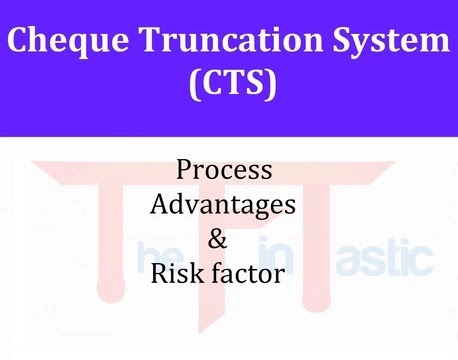Why Cheque Truncation System (CTS)?
RBI has made available online payments between banks and customers in near-real-time in the form of RTGS and NEFT. But still, cheques are an important mode of payment in the country. Physical cheques are still used for more than 75% of all transactions in India.
As the cheques are playing an important role in payments, the RBI has decided to give focus on improving the efficiency of the cheque clearing cycle. CTS also decreases operational risks in banking activities as clearing cheques is a sensitive process in terms of finance and requires complete control and regulation.
Usage of CTS cheques means faster clearance and faster credit of the amount to a person's account. Depending on whether the cheque is local or from other regions, the cheque can be cleared within 24 hours. Thus, CTS provides various benefits to account holders.
How does Cheque Truncation System work?
The cheque truncation system is a bit-by-bit cycle to improve the ordinary methods for cheque clearance.
Following are a portion of the fundamental capacities performed by the gatherings in question while completing the cheque truncation system:
Collection of Cheques: The bank branches at first acknowledges cheques from their customers and sends these gathered instruments to their service bank.
Capturing of Data: At the service bank, the fundamental information identified with the cheque including the cheque no., MICR code, drawee's name, and so on are kept up alongside a scanned image of the cheque. This data is then shipped off the Clearing House through a made sure about Clearing House Interface.
Security of Data: Public Key Infrastructure (PKI) is utilized to guarantee data security. Also, while transferring the information and cheque's image to the Clearing House (from where it is shipped off the drawee bank), this data is encrypted and appropriately endorsed by the introducing bank.
Clearing House Interface: CHI is a gateway that associates and encourages the transfer of data between the introducing bank and the drawee bank.
Presentation Clearing: The Clearing House examines the data and decides the settlement amount.
Processing of Payment: It then advances the data and image to the drawee bank for payment processing. If the cheque is dismissed for reasons unknown, the drawee bank restores the data to the Clearing House and afterward to the introducing bank through a return clearing meeting.
The culmination of Cycle: After the effective execution of the presentation clearing and the return clearing meeting, for example after payment processing or returning of data, the cycle finishes.
Role of MICR in Cheque Truncation System
MICR, i.e., Magnetic Ink Character Reader is mostly utilized in the CTS to identify the data imprinted on specific stationery utilized for a cheque. The MICR has characterized explicit rules which should be trailed by the banks while planning a cheque instrument.
The cheque must have the accompanying highlights:
- Light background tone to highlight the content imprinted on it.
- The banks must dodge the utilization of profoundly inventive or creative plans and small letters.
- Monos, logos, or visualizations should be on the front and expeditiously visible.
The data created by the MICR after processing the cheque is traded or transferred inward and outward between the gatherings through the gateway called the Clearing House Interface.
The MICR can do consequently retouching the data which it identifies to be slightly muddled for producing a superior yield.
Advantages of Cheque Truncating System
- The speed of the cheque clearance procedure has been expanded very fast since there is no requirement for the physical transfer of cheques between the banks.
- As there is no physical movement of cheques from one bank to the next, there is no dread of loss of cheques due to misusing by one or the other bank.
- The Cheque Truncation system has helped the banks to have an unrivaled verification and a successful reconciliation measure.
- The CTS system has killed the geological limitations for the locales. Prior the clearance was confined to the banks working inside the limited topographical zone, however now with this system, the cheques even drawn on heartland banks can be cleared electronically effortlessly.
- The CTS-consistent cheques are inclined to fewer frauds and thus are more made sure about than the old cheques.
- The Cheque Truncation System was advanced to defeat the constraints of the previous cheque clearing system that necessary a few days of clearance. Prior, the cheques deposited in the collection bank should be physically transferred to the drawee bank to get the amount credited to the cabinet's record, which was an unwieldy cycle and brought about the deferral in the clearing of cheques.
Consequently, to defeat this postponement, the register truncation system accompanied practice, wherein the electronic image of the cheque is shipped off the payee bank, which further sends it to the RBI for the last settlement. This entire cycle of cheque clearance gets finished either around the same time or on the following working day.
(Also Read: Unified Payment Interface (UPI))
Risk Involved in Cheque Truncation System
There is a high risk associated with the cheque truncation system. In CTS, cheques are physically investigated. This may prompt dismissal of a genuine cheque, because of being over judgmental; or acknowledgment of fake cheque in carelessness. Indeed, even the verification of the signatures may confront a comparable issue.
(Also Read: How to send money on PhonePe without KYC?)



No comments:
We welcome encouraging, respectful and relevant comments. Thank You!!